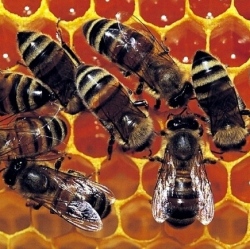
Energy storage could be the next item on the list when it comes to listing all the reasons we need to save the world’s bee population from collapse. A research team at Purdue University has found that bee pollen can be used as an efficient, renewable source for anodes in lithium-ion batteries.
Energy storage has been looming as a gigantic resource consumption and waste disposal problem to solve. The world is already swamped with battery-powered electronic devices of all shapes and sizes, and the growth of solar energy, wind energy, and electric vehicles has added a whole new scale to the global thirst for energy storage.
Much of that activity is centered around lithium-ion (Li-ion) batteries, currently the gold standard for rechargeable energy storage. However, growth in that market bumps up against the cost and availability of critical materials, primarily lithium.
A variety of relatively simple carbon-based materials can be substituted for lithium in the anode and cathode (in a typical battery, those are the two electrodes that carry the charge back and forth to the electrolyte, where it is stored). The advantage is lower cost and greater abundance, but the problem is less than desirable efficiency.
Researchers have been tinkering around with more exotic carbonaceous materials such as carbon nanotubes and graphene. Materials like these promise far greater efficiencies but the cost of synthesizing them creates a new obstacle.
That brings us up to the pollen thing. The general idea is that Mother Nature has spent a long time to craft a highly effective, critical material for Li-ion energy storage that is constantly being produced by billions of “mini-factories” (aka plants), and she has handed it to us on a silver platter, sparing everyone the expense of reinventing the wheel.
You can find the full energy storage study at Scientific Reports from the journal Nature under the title, “From Allergens to Battery Anodes: Nature-Inspired, Pollen Derived Carbon Architectures for Room- and Elevated- Temperature Li-ion Storage.“
It’s a relatively easy read but for those of you on the go, the basic theory is that the miniscule size and complexity of pollen particles would make them an ideal material for energy storage devices, once they are reduced to relatively pure carbon particles.
In the US, pollinator health comes under the umbrella of a joint effort of the U.S. Environmental Protection Agency and the Department of Agriculture. The response to colony collapse disorder and other threats has been slow but some important steps have been emerging since 2014, when President Obama launched the Pollinator Health Task Force.
